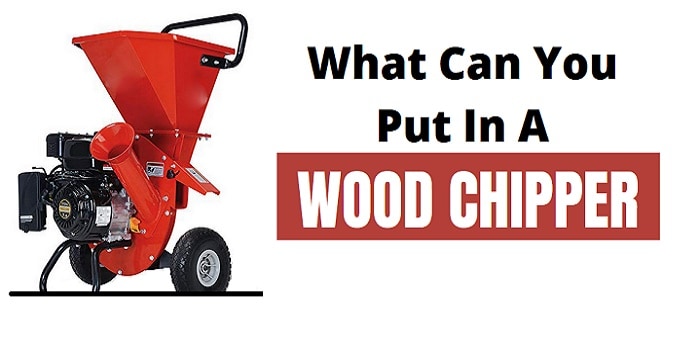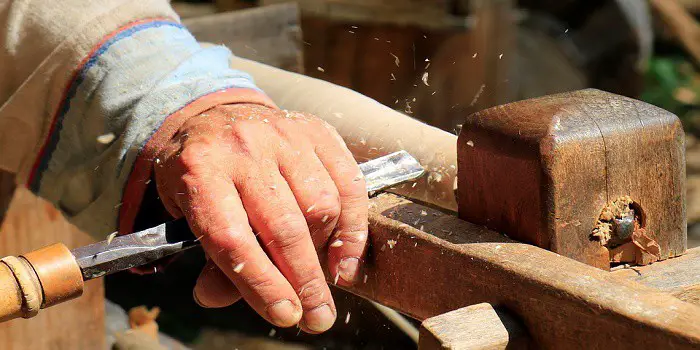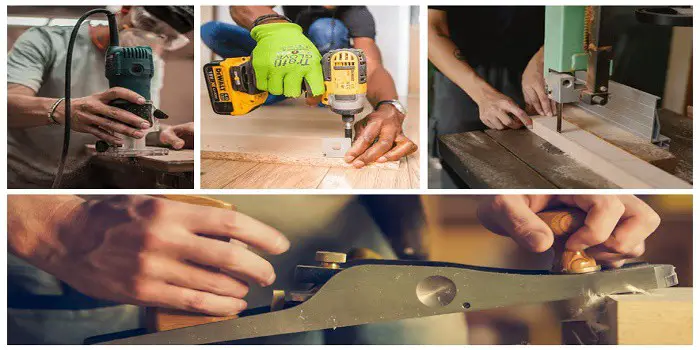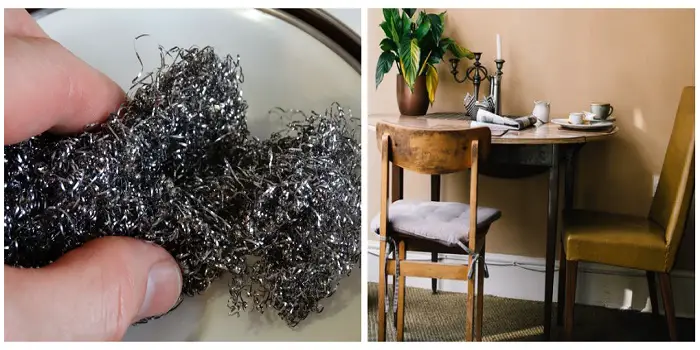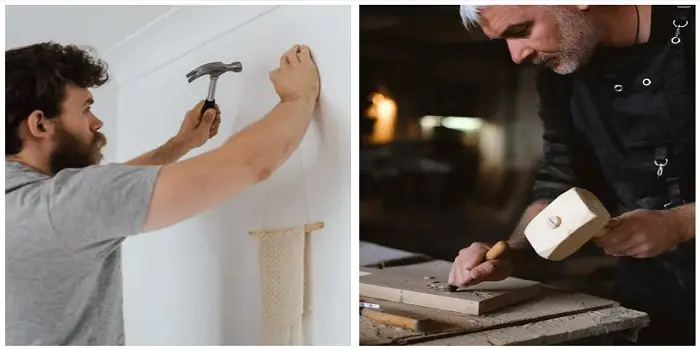
On the surface, hammers and mallets appear to be quite similar. After all, both tools are used to strike blows or create impacts. However, there are some important differences as well.
The most obvious is that a hammer’s head is made from metal, often steel, for durability. While a mallet normally has a wooden or other non-metallic material used for its head.
Another critical difference is that a hammer has more parts to its makeup compared to a mallet. A mallet has a head and handle, while a hammer has a head, handle, and different parts normally on the head for different applications.
Despite the differences, woodworkers have both types in their tool racks for good reasons. Because in addition to the differences in material, the application of the hammer and mallet is also different.
To better understand the differences, it is essential to know the definition of a hammer and mallet, what they do, and their different types, and then know what to use depending on the situation and project you are handling.
So, let’s dive in…
What is a Hammer?
A hammer has a metal head that is weighted and normally made from a hard metallic substance such as steel.
Although non-metallic materials may also be used in the creation of the hammer head.
For hammers, the steel head is a concentrated mass that is used to strike a relatively small area. This is to deliver as much force as possible while still being light enough to carry easily.
That is why hammers are used to drive nails or fasteners because they are the most efficient tool for that particular job.
Driving nails into soft wood is the primary job of the hammer, although its exact function will depend on the specific use along with the size and shape of the head.
The different types of hammers are defined by their application, such as the following.
- Carpentry, Construction, and Framing
- Geology, Masonry, and Mining
- Punching, Upholstery, and Welding
Both nail and staple guns have replaced the hand-held hammer to a certain extent, particularly for carpentry and upholstery.
Hammer Parts
You may be surprised to learn just how many parts make up a hammer because it is more than just two, like a mallet.
a) Claw:
Opposite the face on the head is the claw, peen, or pein.
The claw is a V-shaped structure used to pull nails or fasteners from the material. However, not all hammers will have claws, as some have peens.
A peen or pein is a round bulb-shape on the back of the head. Its size and shape will define its purpose on the hammer.
b) Eye:
This is the hole in the head of the hammer, which may be rectangular, square, or oval-shaped and is normally tapered.
The handle of the hammer is inserted through the eye and then secured with a wedge driven into the top of the handle.
This makes the connection between the head and handles tight, so the head does not fly off when the hammer is being used.
c) Face:
This is the flat part of the head that contacts the object’s surface, usually a nail or fastener, when you apply the impact.
d) Handle:
Put simply; this is where you grip the hammer. It can be made of any hard material, but normally wood is used because it can be secured to the head through the eye.
The structure of the handle also dictates how it can be used.
While wood is the most popular material for the handle, it can also be made of nylon, rubber, or some other composite material.
e) Neck:
This is the narrow part of the hammer head between the face and the eye.
There is no specific purpose associated with the neck. But the shape of the neck may dictate the hammer type.
What is a Mallet?
A mallet may look like a hammer, but the main difference is that it has a non-metallic head.
Mallets are also used to strike the surface, but they do so in a much softer way compared to a hammer. This means the mallet strikes are such that they are not designed to damage the project.
Mallets also have different materials used for its head that define their purpose.
The head of a mallet is most often made from wood, but often they are crafted from a composite of materials. Copper, plastic, and rubber are often used alone or in conjunction with other materials.
Because the head of the mallet is designed to strike a wide, even blow across the surface, the strike that is delivered is often mild to moderate in nature.
Mallets are classified by the composition of their materials but also by their application. They do not have claws, and the heads are attached to the handles via wedges, adhesives, or hardware.
Types of Hammers & Mallets
Hammers had not changed in their basic appearance or use since before civilization began. But different types of hammers have been developed over the centuries.
Today, you can find hammers that have specialized uses. Knowing what type of work you are doing will dictate the type of hammer that will be used. And knowing the basic types of hammers will help you select the right one for the job.
1- Ball-Peen:
This type has a small head with a peen on the backside. The peen is generally used for shaping materials such as metal.
However, you will find the ball-peen used in woodworking shops, which is why it is present on this list.
2- Claw:
This is the most recognizable of all hammers. The face of this type of hammer is used for striking objects, most commonly nails or fasteners.
While the claw on the opposing end is used to pull nails or fasteners from the material.
You can also use the claw to pry open objects such as box lids, for example.
3- Dead Blow:
This type of hammer is used when you need to reduce the recoil from the material that is being struck.
The head of a dead blow hammer contains steel or lead shot or sand that adds to its weight.
Dead blow hammers are used in the same fashion as a mallet, letting you move wrenches so they turn better or loosen screws that are stuck.
4- Drywall Hammer:
This is a hammer designed specifically for use on drywall. It has a flat head that lets you hammer in fasteners. And a hook on the opposing side so you can tear off the drywall or other material with ease.
5- Framing Hammer:
This is another version of the standard nail-driving hammer. When you are building house frames, this is the hammer to use.
The claw on the back tends to be short and straight, while the head has a waffled surface that is compact and round.
A framing hammer is less versatile compared to a claw hammer. It can be used in a wide range of applications.
6- Hatchet Hammer:
As the name suggests, this is a cross between a hammer and a hatchet. The peen on the back has a hatchet shape which lets you cut into or break apart materials.
However, the face will let you join pieces together with a nail or fastener.
7- Tack:
This type of hammer is used to drive tacks or small carpet nails. The tack hammer is generally better than the claw version when driving tacks.
Tack hammers are quite useful for upholstery and securing stair carpets.
Because one end of the head is magnetized, this allows you to hold the tack in place so it can be driven into the material.
8- Trim:
This is a hammer designed to drive small nails for trim work. It has a claw just like a claw hammer but is designed to remove the smaller nails.
The trim hammer is best suited for light woodworking or working tight angles.
As for mallets, despite their simple design, they have several types as well.
9- Joiner’s:
This may be the most recognizable of all mallets. It has a square-shaped head and is often used to impact other tools such as chisels.
However, its main purpose is to hammer joints together without damaging the material. Because of its relatively soft impact, striking the surface away from the intended target often leaves no damage behind.
10- Log Riving:
Sometimes called a froe mallet, this is used to split lumber from green logs. Its design is simple enough to make yourself if you have the right tools.
Especially because riving mallets can be expensive to purchase, if you are processing wood from the lumber, you will need a log riving mallet.
You’ll see it used in lumber yards when logs are split. The riving mallet ensures the quality of the wood is separated from the rest.
You will need to know the exact species of wood that is being split so you can choose the right type of riving mallet.
11- Rubber:
It’s another common mallet that is used when working on surfaces that can easily be dented or scratched.
This includes softwoods such as pine. However, it can also be used for upholstery and even work on sheet metal.
Mallet vs. Hammer: What to Use?
Although similar in appearance, the hammer and mallet have different uses.
Put simply, if your intent is to not damage the material, then a mallet is right for the job.
Mallets are used to gently shape objects, provide additional force for a chisel to be used, and put different parts together that otherwise would be damaged by a hammer.
Mallets have fewer functions compared to a hammer. In fact, the head of the mallet is generally the same on both sides.
Mallets cannot remove fasteners, nor are they designed to strike surfaces with hard impacts.
This is why mallet heads are often attached to the handle using adhesives instead of wedges like a hammer.
If you need to press-fit wooden pieces or plasterboard, then the mallet is the right choice.
In addition, if a hammer causes an unwanted spark on the surface, a mallet may be used instead.
You can tack upholstery and assist in forging metal by using a mallet. Its softer impact is why you see forms of mallets used in games like croquet or when the judge wants to bring order to the court.

Hi, I am Mark Garner a professional carpenter, woodworker, and DIY painter. I live in the small city of Peoria, Arizona as a semi-retired woodworker. I have started this blog with a simple motive to help you with my wood experience in this sector. If you like to know more about what I love doing and how it all got started, you can check more about me here.

